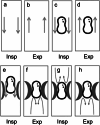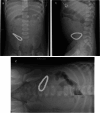Has the cat got your tongue, or is something obstructing your throat? A review of imaging of ingested and aspirated foreign bodies in the paediatric population
- PMID: 39419854
- PMCID: PMC11638315
- DOI: 10.1007/s00247-024-06068-3
Has the cat got your tongue, or is something obstructing your throat? A review of imaging of ingested and aspirated foreign bodies in the paediatric population
Abstract
Children frequently swallow or inhale foreign objects, a situation that can be life-threatening. Radiographic imaging plays a lead role in the early identification and location of inhaled or swallowed objects is essential. Promptly identifying and locating inhaled or swallowed objects are essential, as some items require immediate removal. For example, button batteries in the throat can cause grave harm; magnets can attract each other through the gut and cause perforations; and other objects can obstruct the airway or intestinal tract. Radiologists must understand how these objects appear in images to assist doctors in treating patients effectively. Recognising signs of inhaled objects on radiographs is also crucial, as symptoms may not always be clear, and many inhaled objects are not visible on radiographs. Radiographs are the primary means of checking for swallowed or inhaled objects, although other tests like fluoroscopy and computed tomography may be used in complex cases. Doctors working with children should be acquainted with the appearance of these common objects on images and their clinical importance.
Keywords: Child; Computed tomography; Fluoroscopy; Foreign bodies; Radiography; Ultrasonography.
© 2024. The Author(s).
Conflict of interest statement
Declarations. Competing interests: The authors declare no competing interests.
Figures








References
-
- Karakoç F, Karadağ B, Akbenlioğlu C et al (2002) Foreign body aspiration: what is the outcome? Pediatr Pulmonol 34:30–36 - PubMed
-
- Ngamsanga S, Vathanophas V, Ungkanont K et al (2023) Pediatric respiratory tract foreign bodies in children: a systematic review. Auris Nasus Larynx 50:607–613 - PubMed
-
- Chik KK, Miu TY, Chan CW (2009) Foreign body aspiration in Hong Kong Chinese children. Hong Kong Medical J=Xianggang Yi Xue Za Zhi 15:6–11 - PubMed
-
- Barrios Fontoba JE, Gutierrez C, Lluna J et al (1997) Bronchial foreign body: should bronchoscopy be performed in all patients with a choking crisis? Pediatr Surg Int 12:118–120 - PubMed
Publication types
MeSH terms
LinkOut - more resources
Full Text Sources
Medical
Miscellaneous

